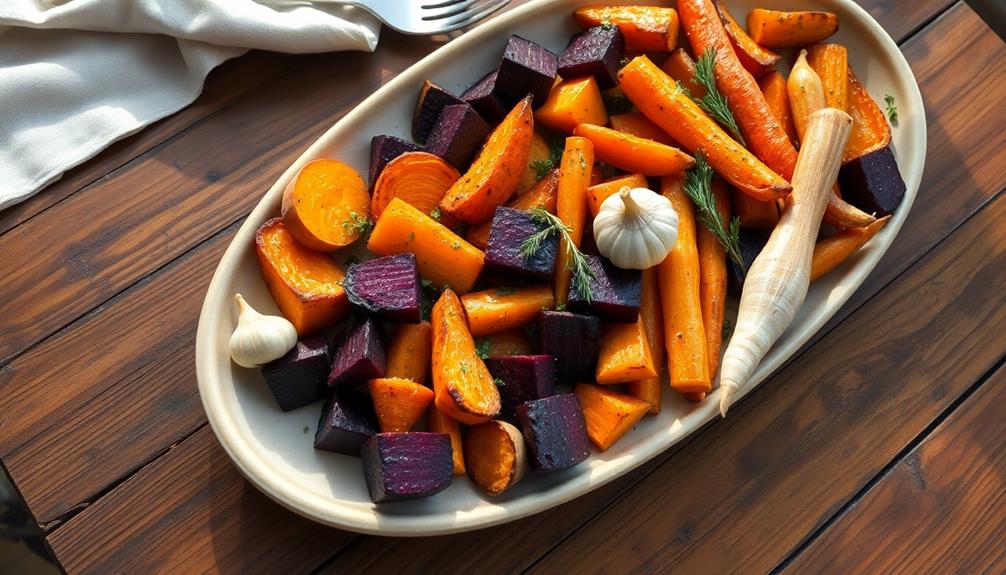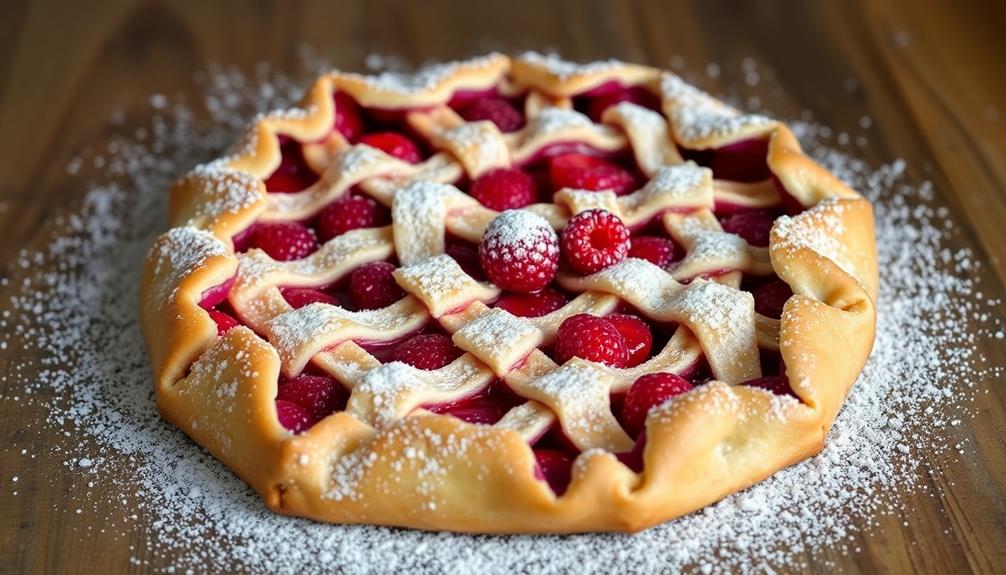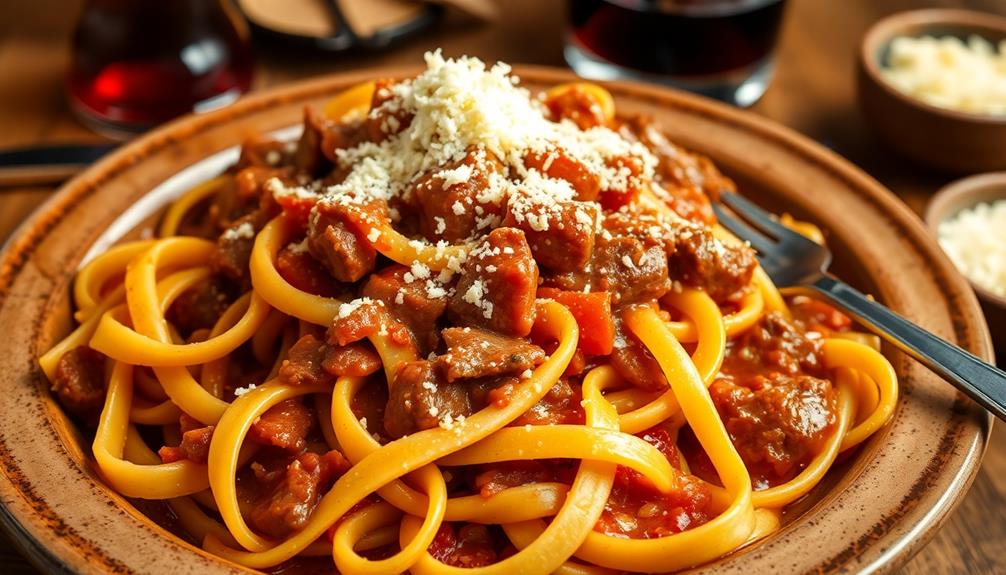Spaghetti carbonara is a tasty Italian pasta dish that's perfect for family dinners. You'll love its creamy sauce made with eggs, cheese, and crispy bacon or pancetta. It's quick to make and uses simple ingredients you might already have at home. To cook it, you'll toss hot pasta with a mixture of eggs and cheese, letting the heat create a silky sauce. Don't forget to add lots of black pepper for that classic carbonara flavor! This dish is great for both casual meals and special occasions. It's a crowd-pleaser that brings everyone to the table with smiles. There's more to discover about this delicious pasta favorite!
Key Takeaways
- Spaghetti Carbonara is an Italian pasta dish made with eggs, hard cheese, cured pork, and black pepper.
- The dish's signature creamy sauce is created by mixing hot pasta with raw eggs and cheese.
- Traditional carbonara does not use cream; the silky texture comes from eggs and cheese alone.
- Key ingredients include spaghetti, eggs, Pecorino Romano or Parmesan cheese, guanciale or pancetta, and black pepper.
- Proper technique involves quickly tossing hot pasta with the egg mixture to create a smooth sauce without scrambling.
History
Although the exact origins of spaghetti carbonara are debated, this iconic Roman pasta dish likely emerged in the mid-20th century.
You'll find that its history is as rich and flavorful as the dish itself!
Some food historians believe carbonara was created during World War II. American soldiers stationed in Italy craved bacon and eggs, and clever Italian cooks combined these ingredients with local pasta and cheese.
It's a delicious blend of cultures!
Others think the dish has older roots, possibly tied to Italian charcoal workers (carbonari). They might've created this hearty meal to fuel their long workdays.
Here are some fun facts about carbonara's history:
- The first written recipe appeared in 1954
- It quickly became popular in Rome's trattorias
- Carbonara Day is celebrated on April 6th
Over time, the recipe has evolved, but the core ingredients remain:
- Pasta (usually spaghetti)
- Eggs
- Hard cheese (Pecorino Romano or Parmesan)
- Cured pork (guanciale or pancetta)
- Black pepper
Today, you can enjoy this creamy, peppery pasta dish in homes and restaurants worldwide.
It's a testament to the joy of simple, delicious food!
Recipe
Spaghetti Carbonara is a classic Italian pasta dish that has gained popularity worldwide for its rich, creamy texture and savory flavor profile. Originating from Rome, this dish traditionally consists of pasta, eggs, hard cheese, cured pork, and black pepper. Several variations of the dish exist, with some recipes incorporating ingredients such as garlic, onions, and peas. One of the best ways to enjoy Spaghetti Carbonara is by pairing it with a glass of Italian red wine and finishing the meal with one of the many delicious Italian gelato flavors, such as pistachio or stracciatella. The combination of rich, creamy pasta followed by a refreshing scoop of gelato makes for a truly indulgent dining experience.
Despite its seemingly simple ingredients, Spaghetti Carbonara requires precise timing and technique to achieve the perfect consistency. The key lies in creating a silky sauce by combining hot pasta with raw eggs and cheese, allowing the residual heat to gently cook the eggs without scrambling them.
- 400g spaghetti
- 150g pancetta or guanciale, diced
- 4 large eggs
- 100g Pecorino Romano cheese, grated
- 100g Parmigiano-Reggiano cheese, grated
- 2 cloves garlic, minced (optional)
- Freshly ground black pepper
- Salt
Cook the spaghetti in a large pot of salted boiling water until al dente. While the pasta cooks, fry the pancetta in a large pan until crispy.
In a bowl, whisk together the eggs, grated cheeses, and black pepper. When the pasta is ready, reserve a cup of pasta water, then drain and immediately add the hot pasta to the pan with the pancetta. Remove from heat and quickly stir in the egg and cheese mixture, tossing continuously to coat the pasta evenly. If needed, add some reserved pasta water to achieve a creamy consistency.
For best results, use room temperature eggs and freshly grated cheese to ensure a smooth sauce. Avoid adding cream, as authentic carbonara relies solely on eggs and cheese for its creamy texture.
Be cautious not to overcook the eggs by keeping the pan off the heat when mixing in the egg mixture. Serve immediately, as the dish tends to thicken as it cools.
Cooking Steps
Get ready to cook up a delicious bowl of spaghetti carbonara!
You'll start by cooking your pasta to perfection and preparing the meat, then mix up a creamy egg and cheese blend.
Step 1. Cook Pasta Until Al Dente
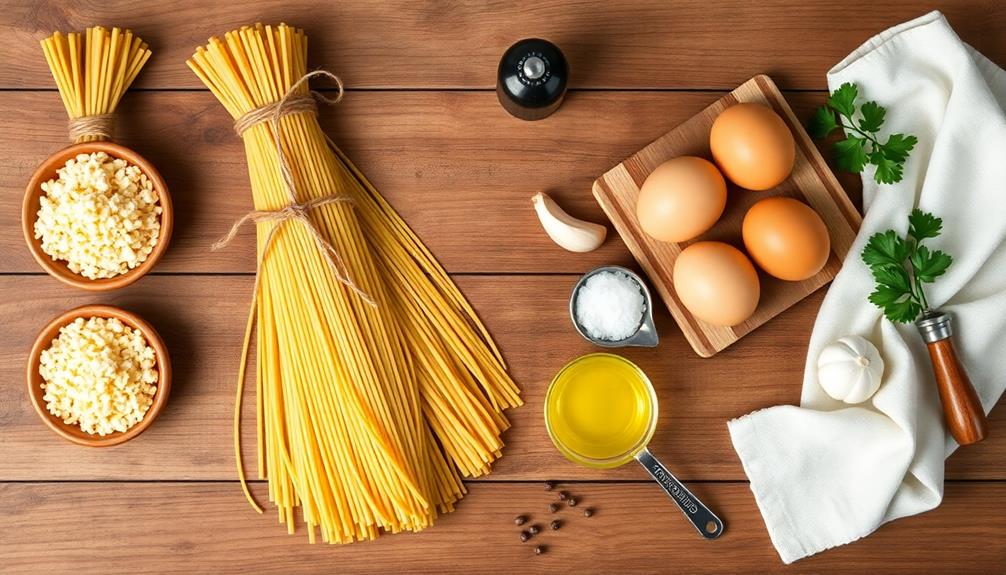
Bring a large pot of salted water to a rolling boil. It's time to cook your pasta to perfection! Add your spaghetti to the bubbling water and give it a gentle stir to prevent sticking.
Keep an eye on the clock, as cooking time varies depending on the brand.
To achieve that perfect al dente texture:
- Taste-test a strand every minute after the 7-minute mark
- Look for a slight resistance when you bite into it
- Remember, the pasta will continue cooking slightly after draining
Don't forget to reserve some pasta water before draining! This starchy liquid is liquid gold for your sauce.
When your pasta is ready:
- Drain it quickly in a colander
- Shake off excess water, but don't rinse
- Return the pasta to the pot immediately
You'll want to work fast to combine your pasta with the sauce while it's still hot and ready to absorb all those delicious flavors.
Your family will love the tender yet slightly firm texture of perfectly cooked al dente pasta in their carbonara!
Step 2. Prepare Guanciale or Pancetta
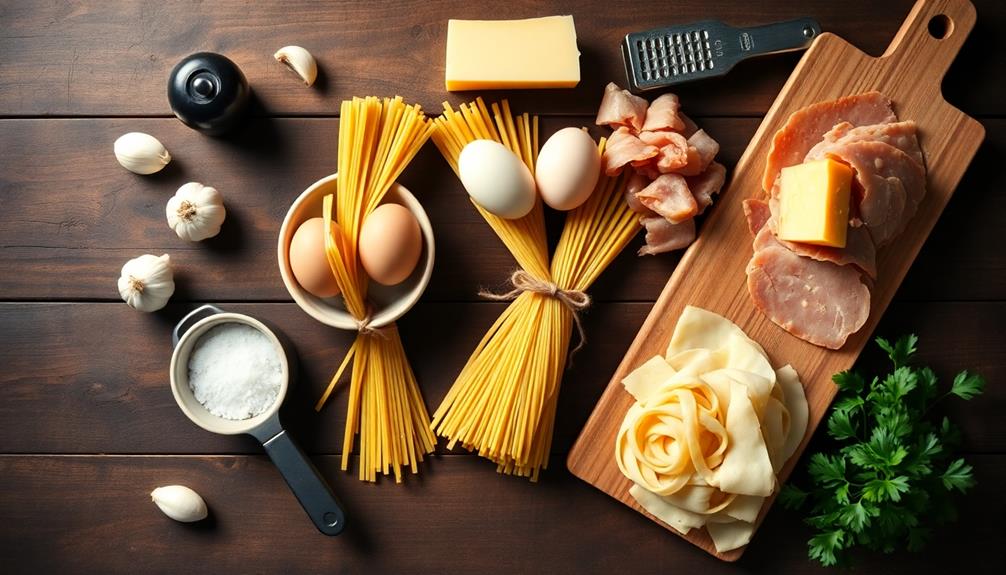
While your pasta is cooking, it's time to prepare the star of the show: the guanciale or pancetta. These Italian cured pork products add a rich, salty flavor to your carbonara. Here's how to get them ready:
- Choose your meat:
- Guanciale: Made from pork jowl, it's the traditional choice
- Pancetta: A good substitute, made from pork belly
- Prep the meat:
- Cut it into small cubes, about 1/4 inch in size
- This helps it cook evenly and mix well with the pasta
- Cook the meat:
- Heat a large skillet over medium heat
- Add the cubed meat to the dry pan (no oil needed!)
- Cook for 5-7 minutes, stirring occasionally
- Watch for changes:
- The meat will start to sizzle and turn golden brown
- Fat will render out, creating a flavorful base for your sauce
- Drain excess fat:
- If there's too much fat in the pan, spoon some out
- Leave just enough to coat the pasta later
Now you've got perfectly crispy, flavorful bits of pork ready to make your carbonara extra delicious!
Step 3. Mix Eggs and Cheese

With the guanciale or pancetta sizzling away, it's time to focus on another key component of carbonara: the egg and cheese mixture. This creamy blend will give your pasta its signature richness and flavor. Here's how to prepare it:
- Crack 3-4 large eggs into a bowl
- Add 1 cup of grated Pecorino Romano cheese
- Sprinkle in some freshly ground black pepper
Now, it's time to whisk! Grab your fork or whisk and mix everything together until it's smooth and well-combined. You'll want to make sure there are no clumps of cheese or egg whites floating around.
As you're mixing, think about the delicious meal you're creating. The eggs will give the sauce its silky texture, while the cheese adds a salty, tangy kick. It's like magic in a bowl!
Remember:
- Use room temperature eggs for better mixing
- Don't add salt yet – the cheese is already salty
- Keep whisking until the mixture looks creamy and uniform
Your egg and cheese mixture is now ready to transform your pasta into a mouthwatering carbonara. Get ready for a taste sensation that'll have everyone asking for seconds!
Step 4. Combine Pasta With Meat Mixture
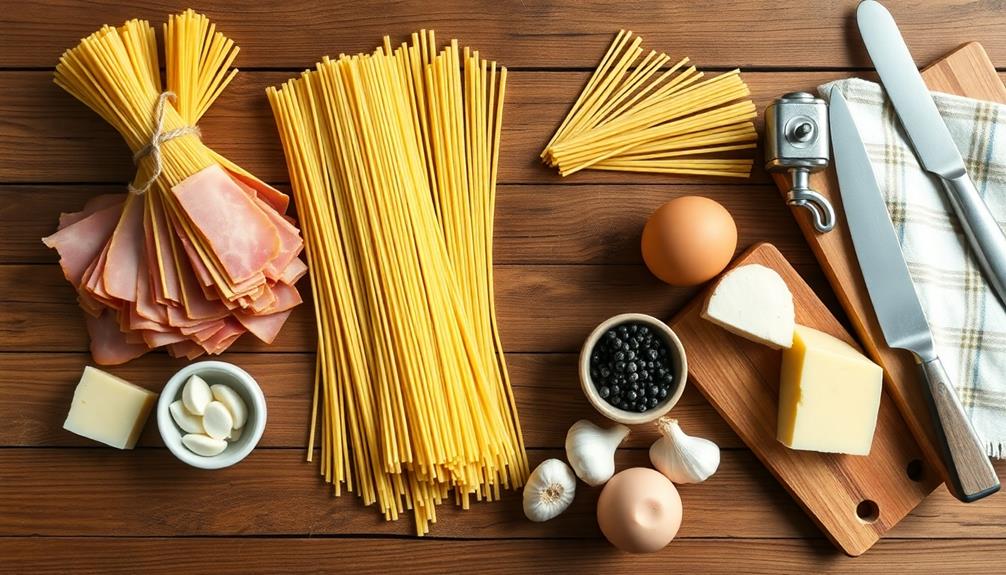
The moment of truth has arrived. It's time to bring all the delicious parts of your carbonara together! Here's how to combine your pasta with the meat mixture:
- Drain your cooked spaghetti, but save a cup of the pasta water.
- Add the hot pasta to the pan with your crispy pancetta or bacon.
- Toss the pasta and meat together, making sure every strand gets coated in the tasty fat.
- Take the pan off the heat – this is crucial!
- Pour in your egg and cheese mixture, stirring quickly.
- Keep stirring to create a creamy sauce that coats the pasta.
- If it's too thick, add a splash of the reserved pasta water.
The heat from the pasta will gently cook the eggs, creating a silky sauce without scrambling.
You'll see the sauce start to cling to the spaghetti, transforming into the carbonara you've been dreaming of!
Step 5. Toss and Serve Immediately
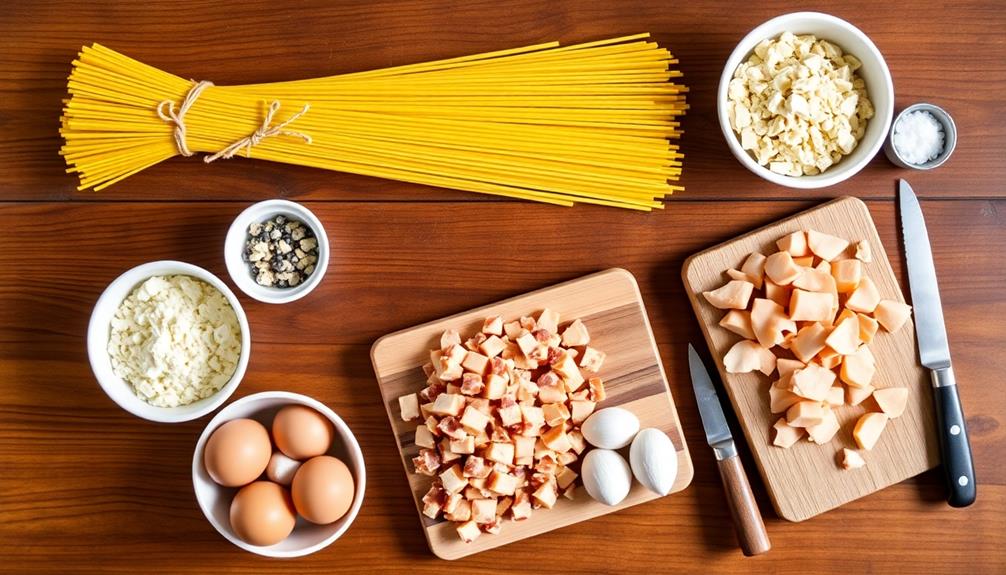
After combining the pasta and meat mixture, you're in the final stretch of creating your perfect carbonara.
Now it's time to toss everything together and get ready to serve. Here's what you need to do:
- Quickly toss the pasta and meat mixture, making sure every strand is coated with the creamy sauce.
- Keep the heat on low to warm everything through without overcooking.
- Add a splash of pasta water if the sauce seems too thick.
- Gently fold in some extra grated Parmesan cheese for added flavor.
As you're tossing, take a moment to appreciate the wonderful aroma filling your kitchen.
It's almost time to dig in! Once everything is well combined and heated through, it's crucial to serve the carbonara right away. The sauce can start to thicken if left too long, so gather your family or guests quickly.
Plate up generous portions, and don't forget to:
- Sprinkle some fresh black pepper on top
- Add a final dusting of Parmesan cheese
- Garnish with chopped parsley for a pop of color
Now, grab your forks and enjoy your delicious homemade spaghetti carbonara while it's hot and creamy!
Final Thoughts
Mastering spaghetti carbonara is a journey worth taking. As you've seen, it's not just about tossing ingredients together. It's an art that brings families and friends to the table, eager to share in the delicious results of your efforts.
Remember these key points:
- Use high-quality ingredients for the best flavor
- Don't overcook the pasta – al dente is perfect
- Keep the heat low when adding the egg mixture
- Toss quickly to create a creamy sauce without scrambling the eggs
Now that you've learned the secrets of this classic dish, you're ready to impress your loved ones.
Carbonara isn't just a meal; it's a celebration of Italian cuisine that you can enjoy any day of the week. Whether it's a cozy family dinner or a festive gathering with friends, your homemade carbonara will be the star of the show.
Frequently Asked Questions
Can Vegetarians Eat Spaghetti Carbonara?
You can't typically eat traditional carbonara as a vegetarian. It contains bacon or pancetta and eggs. However, you'll find vegetarian versions that use plant-based alternatives or skip the meat altogether. These adaptations let you enjoy a similar dish.
What's the Best Cheese Substitute for Pecorino Romano in Carbonara?
You'll find Parmigiano-Reggiano is your best bet to replace pecorino romano. It's less salty but still sharp. If you're looking for a non-dairy option, try nutritional yeast or a vegan parmesan substitute for a similar flavor profile.
How Long Does Leftover Spaghetti Carbonara Last in the Refrigerator?
You'll want to eat your leftover carbonara within 3-4 days. Store it in an airtight container in the fridge. Don't let it sit out at room temperature for more than 2 hours. Reheat thoroughly before eating.
Is It Safe to Eat Carbonara During Pregnancy?
You should be cautious about eating carbonara during pregnancy. It often contains raw or undercooked eggs, which can pose a risk of salmonella. If you're craving it, make sure it's prepared with pasteurized eggs or egg substitutes.
Can You Make Spaghetti Carbonara With Whole Wheat Pasta?
You can definitely make carbonara with whole wheat pasta. It'll give your dish a nuttier flavor and more fiber. Just remember that whole wheat pasta cooks differently, so adjust your cooking time accordingly for the best texture.

